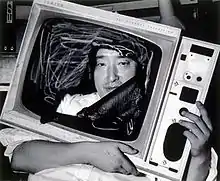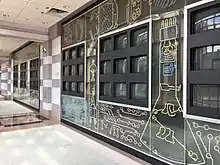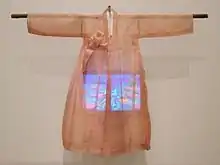Nam June Paik
Nam June Paik (Korean: 백남준; July 20, 1932 – January 29, 2006) was a Korean American artist. He worked with a variety of media and is considered to be the founder of video art.[1][2] He is credited with the first use (1974) of the term "electronic super highway" to describe the future of telecommunications.[3]
Paik Nam June | |
|---|---|
 Nam June Paik in New York City, 1983. Photo by Lim Young-kyun | |
| Born | 20 July 1932 |
| Died | 29 January 2006 (aged 73) |
| Nationality | Korean |
| Education | University of Tokyo, Ludwig Maximilian University of Munich |
| Known for | Video art, performance, installation art |
| Movement | Fluxus |
| Spouse(s) | |
| Awards | |
| Korean name | |
| Hangul | |
| Hanja | |
| Revised Romanization | Baek Namjun |
| McCune–Reischauer | Paek Namjun |
Early life
Born in Seoul in 1932, the youngest of five siblings, Paik had two older brothers and two older sisters. His father (who in 2002 was revealed to be a Chinilpa, or a Korean who collaborated with the Japanese during the latter's occupation of Korea) owned a major textile manufacturing firm. As he was growing up, he was trained as a classical pianist. In 1950, during the Korean War, Paik and his family fled from their home in Korea, first fleeing to Hong Kong, but later moving to Japan. Paik graduated with a BA in aesthetics from the University of Tokyo in 1956, where he wrote a thesis on the composer Arnold Schoenberg.
Paik then moved to West Germany to study music history with composer Thrasybulos Georgiades at Munich University.[4] While studying in Germany, Paik met the composers Karlheinz Stockhausen and John Cage and the conceptual artists Sharon Grace as well as George Maciunas, Joseph Beuys and Wolf Vostell and was from 1962 on, a member of the experimental art movement Fluxus.[5][6]
Works

Nam June Paik then began participating in the Neo-Dada art movement, known as Fluxus, which was inspired by the composer John Cage and his use of everyday sounds and noises in his music. He made his big debut in 1963 at an exhibition known as Exposition of Music-Electronic Television[7] at the Galerie Parnass in Wuppertal in which he scattered televisions everywhere and used magnets to alter or distort their images. In a 1960 piano performance in Cologne, he played Chopin, threw himself on the piano and rushed into the audience, attacking Cage and pianist David Tudor by cutting their clothes with scissors and dumping shampoo on their heads.[8][9]
Cage suggested Paik look into Oriental music and Oriental religion. During 1963 and 1964 the engineers Hideo Uchida and Shuya Abe showed Paik how to interfere with the flow of electrons in color TV sets, work that led to the Abe-Paik video synthesizer, a key element in his future TV work.[10]
In 1964, Paik moved to New York, and began working with classical cellist Charlotte Moorman, to combine his video, music, and performance.[11] In the work TV Cello, the pair stacked televisions on top of one another, so that they formed the shape of an actual cello. When Moorman drew her bow across the "cello," images of her and other cellists playing appeared on the screens.
In 1965, Paik acquired a Sony TCV-2010, a combination unit that contained the first consumer-market video-tape recorder CV-2000. Paik used this VTR to record television broadcasts, frequently manipulating the qualities of the broadcast, and the magnetic tape in process. In 1967 Sony introduced the first truly portable VTR, which featured a portable power supply and handheld camera, the Sony Portapak. With this, Paik could both move and record things, for it was the first portable video and audio recorder.[12][13] From there, Paik became an international celebrity, known for his creative and entertaining works.[14]
In a notorious 1967 incident, Moorman was arrested for going topless while performing in Paik's Opera Sextronique. Two years later, in 1969, they performed TV Bra for Living Sculpture, in which Moorman wore a bra with small TV screens over her breasts.[15] Throughout this period it was his goal to bring music up to speed with art and literature, and make sex an acceptable theme. One of his Fluxus concept works ("Playable Pieces") instructs the performer to "climb inside the vagina of a live female whale." Of the "Playable Pieces," the only one actually to have been performed was by Fluxus composer Joseph Byrd ("Cut your left forearm a distance of ten centimeters.") in 1964 at UCLA's New Music Workshop.[16]
In 1971, he made TV Cello, a cello of sorts formed out of three television sets stacked up on top of each other and some cello strings.[17]
In 1974 Nam June Paik used the term "super highway" in application to telecommunications, which gave rise to the opinion that he may have been the author of the phrase "Information Superhighway".[18] In fact, in his 1974 proposal "Media Planning for the Postindustrial Society – The 21st Century is now only 26 years away" to the Rockefeller Foundation he used a slightly different phrase, "electronic super highway":[19]
"The building of new electronic super highways will become an even huger enterprise. Assuming we connect New York with Los Angeles by means of an electronic telecommunication network that operates in strong transmission ranges, as well as with continental satellites, wave guides, bundled coaxial cable, and later also via laser beam fiber optics: the expenditure would be about the same as for a Moon landing, except that the benefits in term of by-products would be greater.
Also in the 1970s, Paik imagined a global community of viewers for what he called a Video Common Market which would disseminate videos freely.[20] In 1978, Paik collaborated with Dimitri Devyatkin to produce a light hearted comparison of life in two major cities, Media Shuttle: New York-Moscow on WNET.[21] The video is held in museum collections around the world.
Possibly Paik's most famous work, TV Buddha is a video installation depicting a Buddha statue viewing its own live image on a closed circuit TV. Paik created numerous versions of this work using different statues, the first version is from 1974.[22][23][24]
Another piece, Positive Egg, displays a white egg on a black background. In a series of video monitors, increasing in size, the image on the screen becomes larger and larger, until the egg itself becomes an abstract, unrecognizable shape.[25] In Video Fish,[26] from 1975, a series of aquariums arranged in a horizontal line contain live fish swimming in front of an equal number of monitors which show video images of other fish.

Paik completed an installation in 1993 in the NJN Building in Trenton, NJ. This work was commissioned under the public building arts inclusion act of 1978. The installation's media is neon lights incorporated around video screens. This particular piece is currently non-operational, though there are plans to make necessary upgrades/repairs to restore it to working order.
Paik's 1995 piece Electronic Superhighway: Continental U.S., Alaska, Hawaii, on permanent display at the Lincoln Gallery of the Smithsonian American Art Museum.[27]

Paik was known for making robots out of television sets. These were constructed using pieces of wire and metal, but later Paik used parts from radio and television sets.
During the New Year's Day celebration on January 1, 1984, he aired Good Morning, Mr. Orwell, a live link between WNET New York, Centre Pompidou Paris, and South Korea. With the participation of John Cage, Salvador Dalí, Laurie Anderson, Joseph Beuys, Merce Cunningham, Allen Ginsberg and Peter Orlovsky, George Plimpton, and other artists, Paik showed that George Orwell's Big Brother had not arrived. In 1986, Paik created the work Bye Bye Kipling, a tape that mixed live events from Seoul, South Korea; Tokyo, Japan; and New York, USA. Two years later, in 1988 he further showed his love for his home with a piece called The more the better, a giant tower made entirely of 1003 monitors for the Olympic Games being held at Seoul. Despite his stroke, in 2000, he created a millennium satellite broadcast entitled Tiger is Alive and in 2004 designed the installation of monitors and video projections Global Groove 2004[28] for the Deutsche Guggenheim in Berlin.[4]
From 1979 to 1996 Paik was professor at the Kunstakademie Düsseldorf.
Exhibitions
Paik's first exhibition, entitled "Exposition of Music - Electronic Television", was held in 1963 at Galerie Parnass in Wuppertal, Germany. A retrospective of Paik's work was held at the Whitney Museum of American Art in the spring of 1982. Major retrospectives of Paik's work have been organized by Kölnischer Kunstverein (1976), Musée d'art moderne de la Ville de Paris (1978), Whitney Museum of American Art in New York (1982), San Francisco Museum of Modern Art (1989), Kunsthalle Basel (1991) and National Museum of Contemporary Art in Seoul (1992). A final retrospective of his work was held in 2000 at the Guggenheim Museum in New York, with the commissioned site-specific installation Modulation in Sync (2000)[29] integrating the unique space of the museum into the exhibition itself.[30] This coincided with a downtown gallery showing of video artworks by his wife Shigeko Kubota, mainly dealing with his recovery from a stroke he had in 1996.
In 2011, an exhibition centered on Paik's video sculpture One Candle, Candle Projection (1988-2000) opened at the National Gallery of Art in Washington, D.C.[31] Another retrospective was mounted at the Smithsonian American Art Museum in Washington, D.C., in 2012–2013.[32][33] As a leading expert in Paik's work, art historian John G. Hanhardt was the curator for three landmark exhibitions devoted to the artist, the ones at the Whitney Museum, the Guggenheim Museum, and the Smithsonian American Art Museum.[34]
Paik's work also appeared in important group exhibitions such as São Paulo Biennale (1975), Whitney Biennial (1977, 1981, 1983, 1987, and 1989), Documenta 6 and 8 (1977 and 1987), and Venice Biennale (1984 and 1993).[4]
From April 24, 2015, to September 7, 2015, Paik's works T.V. Clock, 9/23/69: Experiment with David Atwood, and ETUDE1 were displayed at "Watch This! Revelations in Media Art" at the Smithsonian American Art Museum.[35]
Collections

Public collections that hold work by Nam June Paik include: the Detroit Institute of Arts, the National Museum of Modern and Contemporary Art (Gwacheon and Seoul, Korea),[36] Leeum, Samsung Museum of Art (Seoul),[37] the Nam June Paik Art Center (Yongin, Korea),[38] the Ackland Art Museum (University of North Carolina), the Albright-Knox Art Gallery (Buffalo, New York), the Art Museum of the Americas (Washington D.C.), Daimler-Chrysler Collection (Berlin), Fukuoka Art Museum (Fukuoka, Japan), the Hirshhorn Museum and Sculpture Garden (Washington D.C.), the Honolulu Museum of Art, Kunsthalle zu Kiel (Germany), Kunstmuseum St. Gallen (Switzerland), Kunstsammlung Nordrhein-Westfalen (Düsseldorf), Ludwig Forum für Internationale Kunst (Aachen, Germany), Musée d'Art Moderne de la Ville de Paris, Museum Wiesbaden (Germany), the National Gallery of Australia (Canberra), the Berardo Collection Museum (Lisbon), |National Museum of Contemporary Art (Athens), Palazzo Cavour (Turin), the Royal Museums of Fine Arts of Belgium, the Stedelijk Museum, Amsterdam, Schleswig-Holstein Museums (Germany), the Smart Museum of Art (University of Chicago), Smith College Museum of Art (Massachusetts), Hessel Museum of Art at Bard College, the Smithsonian American Art Museum (Washington D.C.), the Stuart Collection (University of California, San Diego), the Dayton Art Institute (Dayton, Ohio) and the Walker Art Center (Minneapolis, Minnesota), the Rose Goldsen Archive of New Media Art, Cornell University Library, (Ithaca, New York), The Worcester Art Museum (Worcester, Massachusetts), and Reynolda House Museum of American Art (Winston-Salem, North Carolina).
Honours and awards
- 2007: Order of Cultural Merit.[39]
- 2004: Edward MacDowell Medal in the Arts
- 2001: Lifetime Achievement in Contemporary Sculpture Award, International Sculpture Center.[40]
- 2001: Wilhelm Lehmbruck Prize, awarded by the City of Duisburg
- 1998: Kyoto Prize in Arts and Philosophy
- 1995: Ho-Am Prize in the Arts
- 1993: Golden Lion, Venice Biennale
- 1992: Picasso Medal
- 1991: Goslarer Kaiserring
Archive
Given its largely antiquated technology, Paik's oeuvre poses a unique conservation challenge.[41] In 2006, Nam June Paik's estate asked a group of museums for proposals on how each would use the archive. Out of a group that included the Museum of Modern Art, the J. Paul Getty Museum, the Solomon R. Guggenheim Museum and the Whitney Museum of American Art, it chose the Smithsonian American Art Museum. The archive includes Paik's early writings on art history, history and technology; correspondence with other artists and collaborators like Charlotte Moorman, John Cage, George Maciunas and Wolf Vostell; and a complete collection of videotapes used in his work, as well as production notes, television work, sketches, notebooks, models and plans for videos. It also covers early-model televisions and video projectors, radios, record players, cameras and musical instruments, toys, games, folk sculptures and the desk where he painted in his SoHo studio.[34]
Curator John Hanhardt, an old friend of Paik, says: "It came in great disorder, which made it all the more complicated. It is not like his space was perfectly organized. I think the archive is like a huge memory machine. A wunderkammer, a wonder cabinet of his life."[42] Hanhardt describes the archives in the catalog for the 2012 Smithsonian show in Nam June Paik: Global Visionary.[43]
Michael Mansfield, associate curator of film and media arts at the Smithsonian American Art Museum, supervised the complex installation of several hundred CRT TV sets, the wiring to connect them all, and the software and servers to drive them. He developed an app on his phone to operate every electronic artwork on display.[44]
Many of Paik's early works and writings are collected in a volume edited by Judson Rosebush titled Nam June Paik: Videa 'n' Videology 1959–1973, published by the Everson Museum of Art, Syracuse, New York, in 1974.
Influence
As a pioneer of video art his influence was from a student he met at CalArts named Sharon Grace he described her as "pure genius" from the moment they met. The two met while she was filming fellow students at random with her Sony port-a-pak as an artistic sociological practice akin to the artist in the studio. This led to TV Buddha and the peoples model of the internet as we know it with such art pieces as "Send / Receive". The artwork and ideas of Nam June Paik were a major influence on late 20th-century art and continue to inspire a new generation of artists. Contemporary artists considered to be influenced by Paik include Christian Marclay, Jon Kessler, Cory Arcangel, Ryan Trecartin and Haroon Mirza.[32]
Art market
Christie's holds the auction record for Paik's work since it achieved $646,896 in Hong Kong in 2007 for his Wright Brothers, a 1995 propeller-plane-like tableau comprising 14 TV monitors.[41]
In 2015, Gagosian Gallery acquired the right to represent Paik's artistic estate.[45]
Personal life and death
Paik moved to New York in 1964.[46] In 1977, he married the video artist Shigeko Kubota.[47]
Paik was a lifelong Buddhist who never smoked nor drank alcoholic beverages, and never drove a car.[48]
In 1996, Paik had a stroke, which paralyzed his left side. He used a wheelchair the last decade of his life, though he was able to walk with assistance. He died on January 29, 2006, in Miami, Florida, due to complications from his stroke.[49][50] At the time of his death, he was survived by his wife, as well as by a brother, Ken Paik, and a nephew, Ken Paik Hakuta, an inventor and television personality best known for creating the Wacky WallWalker toy, and who managed Paik's studio in New York.[47][51]
One of his grandsons is Jinu, a South Korean rapper, singer, songwriter, and member of a hip-hop duo Jinusean.
See also
References
- Noah Wardrip-Fruin and Nick Montfort, The New Media Reader, MIT Press, 2003, p227. ISBN 0-262-23227-8
- Judkis, Maura (December 12, 2012). ""Father of video art" Nam June Paik gets American Art Museum exhibit (Photos)". The Washington Post.
- Danzico, Matt; O'Brien, Jane (December 17, 2012). "Visual artist Nam June Paik predicted internet age". BBC News online. Retrieved December 18, 2012.
- Nam June Paik Archived 2014-03-11 at the Wayback Machine Solomon R. Guggenheim Museum, New York.
- Christiane Paul, Digital Art, Thames & Hudson, London, pp. 14–15
- Petra Stegmann. The lunatics are on the loose - EUROPEAN FLUXUS FESTIVALS 1962-1977, DOWN WITH ART!, Potsdam, 2012, ISBN 978-3-9815579-0-9.
- "Media Art Net | Paik, Nam June: Exposition of Music – Electronic Television". Media Art Net. March 22, 2017. Retrieved March 22, 2017.
- Suzanne Muchnic (January 31, 2006), Nam June Paik, 74; Free-Spirited Video Artist Broke Radical New Ground Los Angeles Times.
- Wulf Herzogenrath: Videokunst der 60er Jahre in Deutschland, Kunsthalle Bremen, 2006
- "It's All Baseball: Nam June Paik Starts Out".
- http://www.veniceperformanceart.org/index.php?page=327&lang...
- "The Year Video Art Was Born". Guggenheim. July 15, 2010. Retrieved March 22, 2017.
- "Nam June Paik Starts Making Video".
- Christiane Paul, Digital Art, Thames & Hudson, London, p. 21
- Paik, Nam June; Moorman, Charlotte (1970). "TV-Bra for Living Sculpture (1969)". Cologne: Media Art Net (medienkunstnetz.de).
- Nyman, Michael (1999). Experimental Music. Cambridge University Press. ISBN 978-0-521-65383-1.
- "Nam June Paik: Television Has Attacked Us for a Lifetime". walkerart.org.
- Netart Archived 2009-03-12 at the Wayback Machine
- Paik, Nam June (1974), Media Planning for the Postindustrial Society – The 21st Century is now only 26 years away, Media Art Net (medienkunstnetz.de), retrieved December 18, 2012
- Laura Cumming (December 19, 2010), Nam June Paik – review The Guardian.
- "Electronic Arts Intermix: Media Shuttle: Moscow/New York, Dimitri Devyatkin; Nam June Paik". www.eai.org.
- "Archived copy". Archived from the original on October 10, 2017. Retrieved October 10, 2017.CS1 maint: archived copy as title (link)
- "Looking at Buddha Watching TV - Art + Science". June 2, 2015.
- "Arup Barua, Stress, 2012". Guggenheim. April 22, 2013.
- "Video innovator Nam June Paik dies at 74". TODAY.com.
- Paik, Nam June (1974), Video-fish, World Visit Guide (insecula), retrieved December 18, 2012
- "Electronic Superhighway: Continental U.S., Alaska, Hawaii | Smithsonian American Art Museum". americanart.si.edu.
- A video from this installation can be found in the Experimental Television Center and its Repository in the Rose Goldsen Archive of New Media Art, Cornell University Library
- Mark Stevens (February 21, 2000), Surfing the Guggenheim New York Magazine.
- "The Worlds of Nam June Paik". pastexhibitions.guggenheim.org. Archived from the original on February 14, 2015.
- Press Release: First Nam June Paik Exhibition at National Gallery of Art, Washington, Includes Most Ambitious Installation to Date of "One Candle, Candle Projection" Archived 2013-01-02 at the Wayback Machine National Gallery of Art, Washington, D.C.
- Karen Rosenberg (January 11, 2013), He Tickled His Funny Bone, and Ours New York Times.
- Nam June Paik: Global Visionary, Smithsonian American Art Museum, December 13, 2012-August 11, 2013.
- Carol Vogel (April 30, 2009), Nam June Paik Archive Goes to the Smithsonian New York Times.
- "Online Gallery - Watch This! Revelations in Media Art". Smithsonian American Art Museum. Archived from the original on July 3, 2015. Retrieved July 25, 2015.
- Korea, National Museum of Modern and Contemporary Art. "National Museum of Modern and Contemporary Art, Korea". www.mmca.go.kr.
- "Modern and Contemporary Art | Leeum, Samsung Museum of Art". Modern and Contemporary Art | Leeum, Samsung Museum of Art.
- "NJP ARTCENTER".
- "Nation honors late video artist Paik Nam-june a year after death," Archived 2011-06-23 at the Wayback Machine Ministry of Culture, Sports and Tourism (ROK). February 1, 2007, retrieved 2011-04-22
- International Sculpture Center. Lifetime Achievement in Contemporary Sculpture Award. Retrieved February 13, 2010.
- Rachel Wolff (December 14, 2012), Technological Masterpieces Wall Street Journal.
- "Americanart.si.edu". Archived from the original on June 6, 2013.
- "Nam June Paik". www.goodreads.com.
- Anderson, John (February 6, 2013). "Nam June Paik: Preserving the Human Televisions". Art in America.
- Burns, Charlotte. "Gagosian nets estate of Nam June Paik, grandfather of video art". The Art Newspaper. Archived from the original on September 5, 2015. Retrieved August 30, 2015.
- Palmer, Lauren. "6 Fascinating Facts About Nam June Paik on His Birthday". Art News. Retrieved August 30, 2015.
- Smith, Roberta (January 31, 2006). "Nam June Paik, 73, Dies; Pioneer of Video Art Whose Work Broke Cultural Barriers". The New York Times.
- Smith, Roberta. "Nam June Paik, 73, Dies; Pioneer of Video Art Whose Work Broke Cultural Barriers". The New York Times. Retrieved August 30, 2015.
- "Leader of Avant-Garde Electronic Art Movement Dies at 75". Voice of America. February 1, 2006. Retrieved December 25, 2008.
- Biography for Nam June Paik, Internet Movie Database. Retrieved 2011.1.24
- Abrams, Amah-Rose (December 2, 2016). "Nam June Paik's Nephew Gift to Harvard Museums". Artnet News. Retrieved September 4, 2017.
Bibliography
- Holly Rogers, Sounding the Gallery: Video and the Rise of Art-Music (New York: Oxford University Press, 2013).
External links
| Wikiquote has quotations related to: Nam June Paik |
| Wikimedia Commons has media related to Nam June Paik. |
- Official Website of Nam June Paik
- Nam June Paik Archive at the Smithsonian American Art Museum
- Nam June Paik Art Center at Google Cultural Institute
- 9/23 Paik-Abe videosynthesizer performance from WGBH New Television Workshop archives, features short clip
- Electronic Arts Intermix includes a biography and description of major works
- Nam June Paik biography @ MedienKunstNetz
- Nam June Paik at the Museo Vostell Malpartida
- Nam June Paik at the museum FLUXUS+
- "Father of Video Art Paik Nam-june Dies", The Chosun Ilbo, January 30, 2006.
- Nam June Paik in the Video Data Bank
- Nam June Paik on Ubu Film
- Nam June Paik at IMDb
- Tate: TateShots: Nam June Paik. 2011.
- Nam June Paik in UbuWeb Sound
- Listening
- UbuWeb: Nam June Paik featuring Abschiedssymphonie and In Memoriam George Maciunas MP3s offline
- TV Cello, Nam June Paik & Charlotte Moorman performance (MP3: part 1, part 2)
- Concert for TV Cello and Videotapes, Nam June Paik with Charlotte Moorman and Paul Garrin, Museum of Contemporary Art, Chicago, 1982 (MP3: part 1)
- MP3 Variations on a Theme by Saint-Saens Charlotte Moorman live at Mills College 03/08/1974